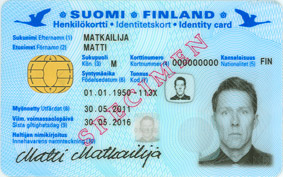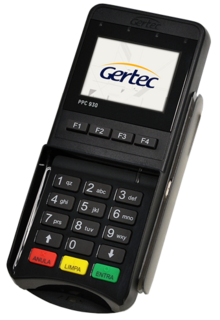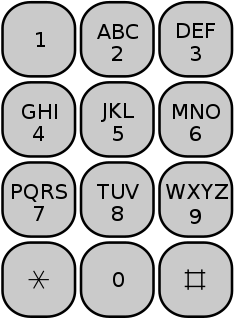
A secure cryptoprocessor is a dedicated computer-on-a-chip or microprocessor for carrying out cryptographic operations, embedded in a packaging with multiple physical security measures, which give it a degree of tamper resistance. Unlike cryptographic processors that output decrypted data onto a bus in a secure environment, a secure cryptoprocessor does not output decrypted data or decrypted program instructions in an environment where security cannot always be maintained.

A smart card, chip card, or integrated circuit card is a physical electronic authorization device, used to control access to a resource. It is typically a plastic credit card-sized card with an embedded integrated circuit (IC) chip. Many smart cards include a pattern of metal contacts to electrically connect to the internal chip. Others are contactless, and some are both. Smart cards can provide personal identification, authentication, data storage, and application processing. Applications include identification, financial, mobile phones (SIM), public transit, computer security, schools, and healthcare. Smart cards may provide strong security authentication for single sign-on (SSO) within organizations. Numerous nations have deployed smart cards throughout their populations.

A subscriber identity module or subscriber identification module (SIM), widely known as a SIM card, is an integrated circuit that is intended to securely store the international mobile subscriber identity (IMSI) number and its related key, which are used to identify and authenticate subscribers on mobile telephony devices. It is also possible to store contact information on many SIM cards. SIM cards are always used on GSM phones; for CDMA phones, they are needed only for LTE-capable handsets. SIM cards can also be used in satellite phones, smart watches, computers, or cameras.

A magnetic stripe card is a type of card capable of storing data by modifying the magnetism of tiny iron-based magnetic particles on a band of magnetic material on the card. The magnetic stripe, sometimes called swipe card or magstripe, is read by swiping past a magnetic reading head. Magnetic stripe cards are commonly used in credit cards, identity cards, and transportation tickets. They may also contain an RFID tag, a transponder device and/or a microchip mostly used for business premises access control or electronic payment.

A personal identification number (PIN), or sometimes redundantly a PIN number, is a numeric or alpha-numeric passcode used in the process of authenticating a user accessing a system.

EMV is a payment method based upon a technical standard for smart payment cards and for payment terminals and automated teller machines which can accept them. EMV originally stood for "Europay, Mastercard, and Visa", the three companies which created the standard.
ISO 8583 is an international standard for financial transaction card originated interchange messaging. It is the International Organization for Standardization standard for systems that exchange electronic transactions initiated by cardholders using payment cards.

A hardware security module (HSM) is a physical computing device that safeguards and manages digital keys, performs encryption and decryption functions for digital signatures, strong authentication and other cryptographic functions. These modules traditionally come in the form of a plug-in card or an external device that attaches directly to a computer or network server. A hardware security module contains one or more secure cryptoprocessor chips.

A contactless smart card is a contactless credential whose dimensions are credit-card size. Its embedded integrated circuits can store data and communicate with a terminal via NFC. Commonplace uses include transit tickets, bank cards and passports.
In cryptography, Derived Unique Key Per Transaction (DUKPT) is a key management scheme in which for every transaction, a unique key is used which is derived from a fixed key. Therefore, if a derived key is compromised, future and past transaction data are still protected since the next or prior keys cannot be determined easily. DUKPT is specified in ANSI X9.24 part 1.

A PIN pad or PIN entry device (PED) is an electronic device used in a debit, credit or smart card-based transaction to accept and encrypt the cardholder's personal identification number (PIN).
A payment card number, primary account number (PAN), or simply a card number, is the card identifier found on payment cards, such as credit cards and debit cards, as well as stored-value cards, gift cards and other similar cards. In some situations the card number is referred to as a bank card number. The card number is primarily a card identifier and does not directly identify the bank account number/s to which the card is/are linked by the issuing entity. The card number prefix identifies the issuer of the card, and the digits that follow are used by the issuing entity to identify the cardholder as a customer and which is then associated by the issuing entity with the customer's designated bank accounts. In the case of stored-value type cards, the association with a particular customer is only made if the prepaid card is reloadable. Card numbers are allocated in accordance with ISO/IEC 7812. The card number is usually prominently embossed on the front of a payment card, and is encoded on the magnetic stripe and chip, but may be imprinted on the back of the card.

E.161 is an ITU-T Recommendation that defines the arrangement of digits, letters, and symbols on telephone keypads and rotary dials. It also defines the recommended mapping between the basic Latin alphabet and digits. Uses for this mapping include:
In cryptography, format-preserving encryption (FPE), refers to encrypting in such a way that the output is in the same format as the input. The meaning of "format" varies. Typically only finite domains are discussed, for example:

A card security code (CSC), card verification data (CVD), card verification number, card verification value (CVV), card verification value code, card verification code (CVC), verification code, or signature panel code (SPC) is a security feature for "card not present" payment card transactions instituted to reduce the incidence of credit card fraud.
Point-to-point encryption (P2PE) is a standard established by the PCI Security Standards Council. Payment solutions that offer similar encryption but do not meet the P2PE standard are referred to as end-to-end encryption (E2Ee) solutions. The objective of P2PE and E2Ee is to provide a payment security solution that instantaneously converts confidential payment card data and information into indecipherable code at the time the card is swiped to prevent hacking and fraud. It is designed to maximize the security of payment card transactions in an increasingly complex regulatory environment.
Utimaco Atalla, founded as Atalla Technovation and formerly known as Atalla Corporation or HP Atalla, is a security vendor, active in the market segments of data security and cryptography. Atalla provides government-grade end-to-end products in network security, and hardware security modules (HSMs) used in automated teller machines (ATMs) and Internet security. The company was founded by Egyptian engineer Mohamed M. Atalla in 1972. Atalla HSMs are the payment card industry's de facto standard, protecting 250 million card transactions daily as of 2013, and securing the majority of the world's ATM transactions as of 2014.
The IBM 4767 PCIe Cryptographic Coprocessor is a hardware security module (HSM) that includes a secure cryptoprocessor implemented on a high-security, tamper resistant, programmable PCIe board. Specialized cryptographic electronics, microprocessor, memory, and random number generator housed within a tamper-responding environment provide a highly secure subsystem in which data processing and cryptography can be performed. Sensitive key material is never exposed outside the physical secure boundary in a clear format.
The IBM 4768 PCIe Cryptographic Coprocessor is a hardware security module (HSM) that includes a secure cryptoprocessor implemented on a high-security, tamper resistant, programmable PCIe board. Specialized cryptographic electronics, microprocessor, memory, and random number generator housed within a tamper-responding environment provide a highly secure subsystem in which data processing and cryptography can be performed. Sensitive key material is never exposed outside the physical secure boundary in a clear format.
The IBM 4769 PCIe Cryptographic Coprocessor is a hardware security module (HSM) that includes a secure cryptoprocessor implemented on a high-security, tamper resistant, programmable PCIe board. Specialized cryptographic electronics, microprocessor, memory, and random number generator housed within a tamper-responding environment provide a highly secure subsystem in which data processing and cryptography can be performed. Sensitive key material is never exposed outside the physical secure boundary in a clear format.










